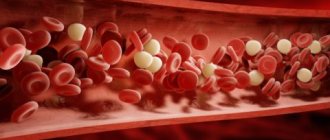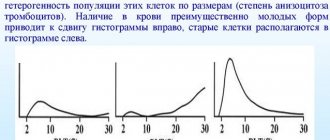Red blood cells and their function in the body
Red blood cells are a cellular unit of blood, the main purpose of which is to saturate the body with all components of the inhaled air. They carry oxygen molecules from lung tissue to internal organs, as well as other parts of the body.
In the opposite direction, red cells remove carbon dioxide from the body, formed after absorbing air. Oxygen delivery is carried out by hemoglobin proteins, which make up 98% of the total mass of protein compounds in red blood cells.
When hemoglobin concentration decreases, the transport function of blood cells is disrupted. Therefore, these indicators must be constantly monitored.
MCV in blood test - what is it?
MCV in a blood test is a determination of the qualitative indicators of the material being studied. It displays the average size of red blood cells and is included in the list of indicators that are required to be identified during a general blood test (CBC).
MCV parameters are included in the list of erythrocyte indices. Performing an MCV analysis allows the doctor to establish quantitative characteristics of the condition of the cells, and then perform a comparative analysis, determining the norm, deficiency of cellular material, or excess of the average volume of erythrocyte units.
Decoding the results
Normal red blood cells, called normocytes, are round, flat cells that are concave on both sides. This shape allows for maximum diffusion surface area while maintaining volume and can easily pass through narrow curved sections of the circulatory system. The MCV indicator in the blood (abbreviation for English mean cell volume, which means “average cell volume”) determines the average volume of a red blood cell.
Important information: How to quickly and effectively lower blood platelets at home using folk remedies (which products reduce them)
Modified red blood cells are not able to efficiently perform their functions of transporting oxygen and carbon dioxide, which can lead to serious consequences. They may have a non-standard shape (elliptocytes, acanthocytes, fragmentocytes, sickle cells, etc.) or differ in size (macro- and microcytes). Such elements may be present only in small quantities, keeping the average volume of red blood cells in the blood within normal limits. If there are many of them, this leads to an increase or decrease in the MSV value.
The results of the MCV blood test allow you to determine the condition of red blood cells and draw conclusions about the presence of certain genetic or acquired pathologies. Laboratory research data is presented in the form of a table containing the names of the relevant parameters and their numerical values. The results are interpreted by a doctor.
MCV analysis is required primarily to determine the type of anemia. Also, an altered erythrocyte volume may indicate an electrolyte imbalance, poisoning, inflammation, lack of vitamins, liver pathologies and other anomalies.
The results of the studies are not always reliable:
- They are distorted in the presence of a large number of deformed red cells.
- The simultaneous presence of enlarged and abnormally small red blood cells gives a false answer about the absence of changes, since cell volumes are averaged.
- The MCV value in a blood test is affected by certain foods, alcohol, steroids, antidepressants and a number of other medications.
- During the process of preparing a blood sample and conducting the study, errors may be made that distort the data.
The information received is sometimes insufficient. Then additional examinations are prescribed. You may need to donate blood again.
Important information: Norm of red blood cells in the blood of men by age (table)
Normal MCV values in adults
MCV as part of a blood test is an indicator that tends to change under the influence of age-related changes in the body of a person donating blood for biochemical research.
The following factors may also affect diagnostic results:
- taking medications belonging to the pharmacological group of antidepressants;
- a hearty breakfast before donating blood;
- prolonged abuse of alcoholic beverages;
- malfunctions of medical equipment.
In young men, the optimal MCV parameters are from 80 to 90 fL. For representatives of the female half of the population, the normal size of red blood cells is from 80 to 95 fl. In women, the MCV rate is slightly higher, which is due to the physiological characteristics of the female reproductive system and monthly blood loss.
Age-related changes in MCV in adults
MCV in a blood test is a determination of qualitative indicators of the cellular composition of the blood, during which age-related changes in the body are taken into account. Below are the erythrocyte indices that are normal for men and women who belong to a specific age group:
| Age | Age-related changes in men (unit fl) | Age-related changes in women (unit of measurement fl) |
| From 14 to 18 years old | 78-94 | 79-99 |
| From 19 to 45 years old | 80-98 | 82-101 |
| From 46 to 65 years | 82-102 | 83-103 |
| Over 66 years old | 84-103 | 84-104 |
When performing a study on MCV parameters, adjusted for age-related changes in body tissues, the factor of the presence of concomitant diseases in the patient being examined, his lifestyle, working conditions, quality of nutrition, addiction to addictions (alcohol, smoking, drugs) are taken into account.
Reasons for rejection
The condition when the average volume of red blood cells is reduced is called microcytosis. The cause may be dehydration in an adult or child due to insufficient water intake or loss of fluid from the body (vomiting, diarrhea).
The MCV value in a blood test will be reduced if the amount of hemoglobin in the blood is low. Also, a state where MCV is reduced is recorded in anemia, which is caused by a violation of hemoglobin formation. The following reasons may influence its development:
- blood iron deficiency;
- chronic diseases;
- some hereditary diseases;
- malignant tumors;
- lead poisoning;
- some types of medicines;
- alcoholism;
- thalassemia (decreased synthesis of one of the hemoglobin chains).
MCV is increased to a small extent in smokers, as well as in women who take contraceptive medications. The reason that this indicator is elevated may be alcohol abuse. This process is reversible: a few weeks after a person stops drinking alcohol, deciphering the results will show normal values.
Also, the average volume of red blood cells in adults and children may be increased in the following situations:
- megaloblastic anemia;
- pernicious anemia;
- hypothyroidism (the thyroid gland synthesizes hormones in insufficient quantities);
- liver diseases;
- intestinal problems;
- decreased activity of the pancreas;
- diseases of the red brain, which is responsible for the production of red blood cells;
- poisoning.
Deciphering the analysis may show that increased MCV levels in adults and children are also possible due to a lack of vitamins B12 and B9 in the body. In this case, the doctor prescribes a vitamin-mineral complex and recommends an appropriate diet.
As the body ages
MCV in a blood test is a determination of the qualitative indicators of the test material, which change throughout the entire life cycle, but not significantly. The only thing that is observed in both men and women is a slight increase in the average cell size.
This is explained by the fact that with age, body weight increases and intracellular metabolism deteriorates. To provide more tissues with the necessary level of oxygen, the body increases the average size of the red blood cells synthesized.
Normal MCV values in children by age
At all stages of development of the child's body, changes in MCV parameters are observed. The table below shows the optimal average sizes of red blood cell units in children, taking into account the age group.
| Age | Normal level (measurement value fl) |
| In infants | Up to 140 |
| From 1 month up to 1 year | 71-84 |
| From 2 to 5 years | 73-85 |
| From 5 to 10 years | 75-87 |
| From 11 years and older | 80-100 |
MCV in a blood test is a determination of the qualitative indicators of the test material, which play a key role in the diagnosis of blood diseases in children of all age groups. Therefore, if a child is prescribed OAC, then identifying the normal average size of erythrocyte units is a prerequisite for diagnosis.
Some reasons for lower and higher values
Reduced values
Let's consider under what conditions the MCV norm can be violated, and what are the possible causes of deviations, what can they tell the doctor and laboratory assistant about the state of human health?
First of all, you need to understand that low values, at which the indicator is below 80 fL, can be clearly interpreted as a disease, since there is not enough hemoglobin in the red blood cell. In the same case, if the volume increases, this does not always indicate a disease; it may be, as in the case of the age norm, a compensatory reaction to changed living conditions.
The main reasons for the decrease in values are:
- iron deficiency anemia, in which there is a lack of iron in the body;
- secondary chronic diseases leading to anemia: pathology of both red bone marrow and the presence of chronic blood loss, for example, with dysfunctional uterine bleeding;
- hereditary blood diseases - thalassemia, hemoglobinopathies;
- hyperthyroidism.
It is on the basis of this index that a blood test suggests the classification of anemia into normocytic, macrocytic and microcytic. Here we are talking about hypochromia of erythrocytes. The laboratory doctor no longer has to tediously examine a smear under a microscope and visually compare the cell size with standard values. When the volume of red blood cells decreases, microcytosis occurs, which is recorded by the device.
Increased values
An increase in MCV, in which red cells have a volume of more than 100 fl in adults, and more than 105 fl in the elderly, occurs for the following reasons:
- decreased thyroid function, hypothyroidism or myxedema;
- chronic diseases of the liver and gastrointestinal tract, leading to the development of folate deficiency anemia;
- aplastic anemia and similar bone marrow damage, for example in cancer patients, as well as in patients on immunosuppressive therapy;
- B-12 deficiency anemia leading to megaloblasts - increased blood cell size;
- various types of autoimmune anemia.
Finally, a long history of smoking and drinking alcohol also leads to endogenous intoxication and vitamin deficiency, which can manifest itself as macrocytosis, that is, an increase in the size and average volume of red blood cells. In this case, there may also be changes in the level of red blood cells downward, or anemia may develop.
Do not think that anemia is manifested only by a decrease in cell volume. Anemia is an insidious group of diseases of different etiologies and different mechanisms of origin. But they have one thing in common: the symptoms of anemia, in any case, are manifested by chronic hypoxia of organs and tissues.
In conclusion, it should be noted that in case of acute anemia, determining the above-described indices does not make sense, due to the lack of information content. After all, during acute bleeding, neither the volume nor the shape of the red blood cell will change. The study of this indicator allows us to identify only chronic diseases in which the production of healthy red blood cells is somehow impaired, and there may be no symptoms.
How is the MCV blood test performed?
To determine the MCV level, you need to visit a laboratory that specializes in determining quality blood parameters, or take tests at a local clinic.
To obtain the most accurate diagnostic results with minimal risk of data errors, you will need to follow the rules for preparing for the donation of biological material, undergo the blood sampling procedure and wait for the test results.
Preparation
Includes the implementation of the following recommendations, which allow you to maintain the cellular composition of the blood at an optimal level without provoking its sudden changes.
The patient who will be tested will need to follow the following rules:
- 3 days before blood sampling, do not drink alcohol;
- take the test in the morning (preferably before 10-00);
- 2 days before diagnosis, exclude physical activity, do not engage in strength sports, do not lift heavy objects;
- have breakfast only after blood sampling, so that the stomach is empty (the best option would be to eat wheat, rice, pearl barley, barley porridge with vegetable salad).
It is recommended not to smoke 8 hours before donating blood. In the evening the day before the test, you should not overeat. All food consumed before laboratory testing should be light and not burden the digestive system.
Blood collection
A mandatory condition for submitting biological material for testing for MCV levels is taking blood on an empty stomach.
This procedure is performed using two methods, namely:
- ring finger bundle - pierced with an automatic pen with needles or a metal scarifier (about 1-2 ml of blood is taken by a laboratory assistant);
- ulnar vein — collection of biological material is carried out with a disposable syringe, which is filled with 5-10 ml of blood.
In order to obtain the most accurate research results, it is advisable to perform simultaneous collection of capillary and venous blood. This will allow for a comparative analysis of the selected samples, eliminating the possible occurrence of inaccuracies and errors in the operation of medical equipment.
How long to wait for answers
Modern medical equipment allows you to obtain laboratory test results for the MCV level within 15-20 minutes.
after delivery of biological material. In most cases, determining the average size of red blood cell units is only 1 of more than 20 parameters of the cellular composition of the blood that laboratory specialists need to determine.
If the staff of the clinic where the collected blood is tested uses automatic analyzers, the diagnostic process is significantly accelerated.
In laboratories that are not equipped with modern medical equipment and use microscopic research techniques, you will need to wait from 1 to 2 hours. In this case, the laboratory assistant performs an independent blood test, establishing the average volume of red blood cells using a microscope.
It is believed that the microscopic diagnostic method carries a greater number of errors, because there is a human factor involved. In order to save personal time and obtain the most accurate diagnostic results, it is recommended to donate blood in laboratories that are equipped with automatic analyzers.
Comparative study
To ensure a comparative study on MCV, simultaneous sampling of capillary (ring finger) and venous blood is performed.
The laboratory specialist places both samples into the analyzer and, based on the diagnostic results, checks the data obtained. This research method makes it possible to eliminate the factor of incorrect operation of medical equipment and minimize the likelihood of obtaining a false result.
Reasons for increasing MCV
A violation of the MCV norm in the direction of an increase in the average cell size may indicate the occurrence of blood diseases or indicate a pathological condition of internal organs.
The following reasons for increased MCV in the bloodstream are identified:
- intoxication of the body with antibacterial drugs or medications included in the group of antidepressants;
MCV in blood tests increases with illness - bacterial infection that caused extensive inflammation;
- uncontrolled use of steroid drugs or contraceptives based on synthetic hormones;
- severe liver diseases in the form of cirrhosis, viral or intoxicating hepatitis;
- long-term use of strong alcoholic drinks;
- autoimmune pathologies, which are expressed in disruption of the process of red blood cell synthesis;
- prolonged contact with chemicals of toxic etiology, the compounds of which saturate the blood;
- iron and iodine deficiency in the body caused by poor diet or other factors;
- diseases of the thyroid gland associated with insufficient or excessive synthesis of hormones.
Most patients with MCV levels exceeding the norm experience characteristic symptoms in the form of causeless pain in the abdominal cavity, pale skin (if liver pathology is present, yellowing of the skin and whites of the eyes is possible), increased heart rate, and shortness of breath.
At risk are people who lead a sedentary lifestyle, as well as those with a genetic predisposition.
Reasons for the decrease in the indicator
A decrease in the average size of erythrocyte units is no less dangerous than an increase in blood cell parameters. The internal organs and tissues of the body begin to experience an acute lack of nutrients, oxygen starvation of cells and premature death occurs. A person quickly loses weight, and dysfunction of internal organs and systems develops.
The reasons for the decrease in MCV are the following factors:
- porphyria or a hereditary predisposition to the body producing defective cells;
- heavy metal poisoning (most often a similar clinical picture occurs in people who have been in contact with lead vapor);
- the presence of cancer of the blood or internal organs;
- severe dehydration of the body;
- long-term use of medications, the side effect of which is a decrease in the average volume of red blood cells;
- anemia of all types.
People who have a low MCV complain of constant fatigue, loss of physical strength, become absent-minded, cannot concentrate, and the thought process is disrupted.
The nervous system exhibits symptoms such as increased irritability, depression, rapid mood swings, and memory impairment. If these signs appear, you should consult a doctor as soon as possible.
Classification and causes of microcytic (MCV lowered) anemia
Anemia is a group of diseases of the human circulatory system, which is expressed in a decrease in hemoglobin levels, as well as a reduction in the average volume of red blood cells.
This pathology is classified according to the causative factors that provoked its development, namely:
- allastic - caused by systemic dysfunction of the bone marrow, as a result of which the process of synthesis and maturation of blood cells is disrupted;
- iron deficiency - there is a decrease in the rate of hemoglobin production, since the patient’s body does not receive enough iron;
- thalassemia is a hereditary type of anemia that occurs due to the fact that the body is not able to form sufficiently strong polypeptide bonds in the protein compounds of hemoglobin;
- hemolytic - develops when the level of dead cells exceeds the number of new red blood cells.
A type of microcytic anemia is taken into account by the attending physician when making a diagnosis, as well as during the formation of a therapeutic course. Eliminating the pathological causes of the disease is a prerequisite for successful treatment.
Cell Variability
Under the constant influence of a number of environmental factors, the occurrence of biochemical and physiological adaptation of blood cells cannot be ruled out.
Variability in the average volume of red blood cells is possible under the following conditions:
- prolonged abuse of alcoholic beverages (alcohol addiction);
- daily contact with toxic substances;
- eating excess amounts of protein foods;
- deficiency of foods containing iron and vitamin B12.
Sooner or later, physiological variability of cells leads to the development of diseases of the blood, as well as tissues of internal organs that suffer from an increased or decreased MCV. Most often, the pathological state of cells leads to the development of blood cancer.
Increased values
A marked increase in MCV indicates the development of macrocytosis (macrocytic anemia). In this case, the size and volume of red blood cells increases, and a drop in hemoglobin levels is observed. If the hemoglobin concentration is not lower than the permissible value, this indicates alcohol abuse.
Other reasons for the increase in the indicator:
- deficiency of B vitamins (folic acid and cyanocobalamin) or impaired absorption;
- hemolysis;
- suppression of bone marrow functions;
- some autoimmune diseases;
- myelodysplastic syndrome;
- drug intoxication;
- hormonal imbalances due to disruption of the thyroid gland;
- liver damage, hepatitis, malignant neoplasms;
- imbalance of intestinal microflora;
- infectious and inflammatory process.
Important information: What is platelet aggregation in the blood (analysis transcript)
Symptoms of macrocytic anemia include abdominal pain, pale skin, severe fatigue, palpitations, migraines, hypotension, and frequent colds.
A slight excess of standard values can be observed in the absence of systemic pathologies, for example, due to nicotine addiction, hormonal contraception, taking certain medications, bleeding, regular contact with toxic compounds, etc.
A false overestimated result can be obtained with sickle cell anemia, diabetic ketoacidosis, and red blood cell agglutination.
Correlation of MCV with other erythrocyte indices
When determining the MCV indicator, a prerequisite for a blood test is the establishment of other erythrocyte indices.
The average volume of red blood cells correlates with the following indicators:
- MCH - displays the average mass of hemoglobin in each individual red blood cell (normal values are from 27 to 31 pg), and the comparative analysis takes into account the ratio of “hemoglobin level/numerical number of red blood cells”;
- ICSU — shows the average level of hemoglobin not in whole blood, but only in the erythrocyte mass (the norm is from 320 to 360 g/l).
Medical practice shows that a violation of at least one of the listed erythrocyte indices affects other characteristics of the cellular composition of the blood. All of the above indicators make it possible to determine the level of hemoglobin and promptly prevent its decrease and the development of blood diseases.
How to calculate MCV
To calculate the average volume of a red blood cell, divide the sum of cell volumes by the total number of red blood cells. Another calculation method is based on dividing the hematocrit, or the number for 1 mm3 of blood, by the number of total red blood cells. The hematocrit number refers to the percentage ratio between the volume of blood cells and the total volume of blood.
The MCV blood test, which involves assessing the size of red blood cells, is considered less accurate than the other two calculation methods. This is due to the fact that when the diameter of a red blood cell changes by 5%, its volume changes by 15%. The reliability of this indicator may be distorted when there are a large number of red blood cells that have changed shape. For example, if a complete blood count is performed, the MCV value will be normal if the patient has both macro- and microcytosis.
It should be taken into account that the diameter of microspherocytes is usually underestimated, but the average volume is within the normal range, which is why microscopy of a blood smear is always recommended.
What to do if the indicator deviates from the norm
If the results of a general blood test show a deviation from the norm in the average size of erythrocyte units in the direction of increasing or decreasing their size, the following steps must be taken:
- together with your doctor, try to establish the causative factor influencing the change in red blood cells;
- streamline the daily routine, balance the diet, saturating it with foods containing a sufficient amount of iron, iodine, vitamin B6, B12 (veal, nutria meat, rabbit, turkey, legumes, nuts, ocean fish, seaweed, shellfish, crustaceans);
- take medications that will be prescribed by your doctor;
- completely stop using alcoholic beverages, tobacco products and drugs;
- Avoid a sedentary lifestyle, engage in cycling, athletics, and swimming.
MCV as part of a blood test is an indicator that tends to change under the influence of environmental factors. Therefore, in order for the average cell volume to reach optimal levels, an integrated approach is required using drug therapy, compliance with the instructions of the attending physician and dietary standards.
Article design: Mila Friedan
What does MCV mean?
The MCV indicator is an erythrocyte index that characterizes the average volume of erythrocytes. To establish an accurate diagnosis of the disease, doctors always prescribe a clinical blood test to patients. MCV decoding talks about the state of blood cells in the human body. In healthy people, the ratio of red blood cells to the total blood volume is constant, which means their size and number should not change.
You can find out about the development of allergies, inflammatory processes, lack of vitamins and minerals by taking an MCV blood test. A transcript of its results, showing deviations from the norm, indicates possible pathological conditions.
This indicator is determined both during a general clinical blood test and as a separate study.











